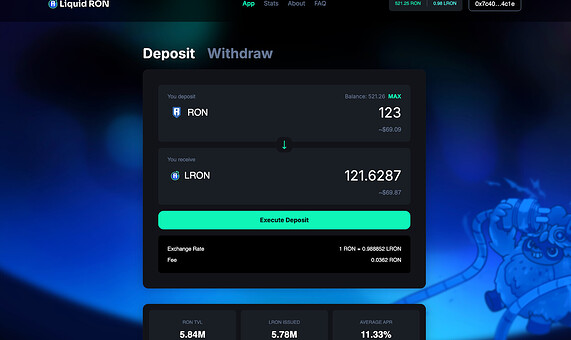Introduction
Liquid RON is a Ronin staking protocol that automates user staking actions. It is an LST and behaves similarly to interest bearing tokens like Lido’s WSTETH or RocketPool’s RETH.
Deposit RON, get Liquid RON, a token representing your stake in the validation process of the Ronin Network.
The aim of this protocol is simply staking with automation and unlock liquidity in the staking protocol to be used in DeFi and in the Ronin ecosystem.
Type: Collateral deployment
Authors: Owl Of Moistness
Motivation
Liquid RON is one of many DeFi/web3 protocols that launched with Open Ronin.
Other projects like Compound, merkl or OpenSea have also joined the ecosystem recently.
The motivation behind listing Liquid RON as a collateral is to further enhance the interoperability of protocols and assets in the ecosystem, and grow Defi on Ronin.
Liquid RON unlocks liquidity, Compound borrow markets takes in liquidity and allows users to borrow from it. This is a perfect use-case for Liquid RON. Over 240 million RON tokens are staked in Ronin’s staking protocol. Liquid RON currently has 6.9 million of those RON tokens and is increasing steadily.
Staked tokens are not active by nature. By allowing users to use their staked shares via liquid RON on compound to borrow RON, they are able to make their assets more efficient. And by doing so, generate more revenue on Compound with the interest rates from the borrow side.
We would like to allow users to borrow RON against liquid RON and potentially explore other markets like USDC. If a position were to be liquidated, simply redeeming Liquid RON back to RON would allow the position to be repaid fully.
DEX Liquidity matters when it comes to adding a new collateral type on Compound, to ensure that if a position were to be liquidated, no bad debt would occur due to high slippage.
A standard flow of liquidation would look like the following image:
This flow requires the DEX liquidity to be sufficient to be able to liquidate a position without much slippage.
No pool liquidity required directly for Liquid RON
Compound’s liquidation flow doesn’t give out the collateral first than callbacks to expect payment. You must pay for the collateral with the base token (RON), then receive the collateral (Liquid RON).
Normally, we would use Katana (AMM on Ronin) to proceed with a standard swap since Katana V3, being a uniswap V3 fork, sends tokens first and the callbacks to expect reception.
One great advantage of Liquid RON is that it can be unwrapped atomically back to RON. The Ronin staking protocol has some rules that prevents stakes from being removed if you’ve staked in the last 72 hours. Liquid RON partially solves this issue by spreading its stakes on multiple addresses. So assuming 5 different staked addresses, at worst you’d have 40% of ron available for unwrapping, with on average a much higher percentage because the delegation strategy wouldn’t necessarily restake on all validators all at once. On average this is much higher since restaking/unstaking on the Liquid RON protocol will usually happen on the same validators, making the other validators free to be unstaked completely.
This system solves obtaining the RON from liquid RON.
As the base token is RON, and that we can unwrap Liquid RON back to RON, we don’t need to execute swaps but simply flashloan RON from any pool that contains RON.
The flow of liquidation would look like this:
- absorb accounts under water
- calculate how much Liquid RON is up for sale and quote how much RON is needed to buy collateral
- Flash call enough v3 pools with RON as one of the token in pair to receive enough RON to buy collateral
- Buy collateral and proceed to redeeming Liquid RON back to RON
- Repay flash loans with newly acquired RON
Here’s another image explaining the setup:
You can find this flow on this proof of concept contract.
DEX liquidity of the collateral isn’t that important, it’s how much RON there is on the v3 market as well as how much RON can be redeemed at any given time. Furthermore, a larger spread out stake equals a higher redemption amount so this number can be increased to strengthen the choice of Liquid RON as a compound collateral since that would allow the supply cap of Liquid RON to be higher.
Summary
With the possibility of redeeming Liquid RON back RON atomically and leveraging flash loan capacity of the v3 dex markets, the bottlenecks for liquidation are the total sum of RON on all v3 pools as well as the theoretical max amount of redemption of liquid RON back to RON (which can be increased).
Incorporating Liquid RON as a collateral aligns with Compound’s vision of using active asset classes and due to the flexibility of Liquid RON, minimises liquidation flow risks.
In addition, we could open a discussion to allow Liquid ron as a collateral for the USDC market. Since Liquid RON behaves very similarly to RON, similar supply caps could be introduced using the flash loan setup explained earlier.
Important Links
- Website: https://www.liquidron.com
- Current Marketcap: 6.9 million tokens, dynamic based on how may RON tokens are deposited.
- Katana LRON:RON pool: https://app.roninchain.com/liquidity/v3/0x0fbe1a7f0f006a4a4d817b2aa922889612758ce8
- Liquidator contract PoC: liquid_ron/src/liquidator/LiquidRonCompLiquidator.sol at feat/compound_liquidator_bot · OwlOfMoistness/liquid_ron · GitHub
- CoinGecko: https://www.coingecko.com/en/coins/liquid-ron
- DefiLlama: https://defillama.com/protocol/liquid-ron
- Audits: Code4rena | Keeping high severity bugs out of production
Next Steps
We invite the community to give their feedback and recommendations for the asset.


